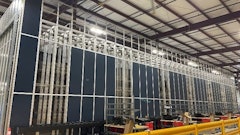
At times, manufacturing can feel like a fragile ecosystem, knock one piece down and a domino effect ensues. In discrete manufacturing, if one component is late or damaged it can ripple across the production line, halting or shutting down the process entirely. Damaged or faulty components can lead to dangerous recalls. In high-stake industries, such as aerospace or defense, inventory management can be the barrier between a flourishing business and serious scandal. In 2023, aerospace supplier Pratt & Whitney recalled hundreds of aircraft engines due to a manufacturing issue, damaging their reputation with clients and potential clients alike. Supply chain issues have also sent aerospace supplier Incora into bankruptcy; the stakes are clearly very high.
Effective resource management is non-negotiable, especially in industries like discrete manufacturing which pose distinct hurdles. Complex products with detailed bills of materials require several components and sub-assemblies. Without significant tracking and warehouse management, manufacturers could risk stockouts or tie up cash in surplus inventories, slowing down or halting production and may even lead a business to bankruptcy.
Component lead time variability further complicates matters, demanding strategic planning to synchronize material availability with production needs. Manufacturers must be prepared for supply chain disruptions. A 2024 survey by the National Association of Manufacturers found that 25% of manufacturers cite supply chain challenges as their primary business concern. The frequent production schedule changes inherent to discrete manufacturing can disrupt even well-laid inventory plans, subsequently disjointing warehouse processes. The continual turmoil underscores the need for agile and adaptive management practices and tools to allow manufacturers to anticipate and prepare for inevitable disruptions. A unified approach to both warehousing and inventory functions can enhance visibility, prevent inconsistencies, and maximize resource utilization throughout the supply chain.
Mastering the Maze of Inventory Movement
Inventory management is far more than a mundane task of keeping shelves stocked. It requires significant strategy, demanding orchestration of complex materials and components to meet production goals while keeping costs in check. For the savvy manufacturer, mastering this maze is crucial to success. At its core, effective inventory management ensures production continuity. It's about keeping the machines running, so to speak. Having the right materials on hand allows the shop floor to continue operating, pacing is on par, and there are no significant gaps in output. This approach prevents costly downtime, missed deadlines, and potential revenue losses.
Quality consistency is another vital outcome of stellar inventory management. Success hinges on having the right pieces in place for assembly. When production lines have access to the necessary materials, they can consistently produce high-quality products that meet or exceed customer expectations.
Resource utilization in inventory management follows the Goldilocks principle—not too much, not too little, but just right. Smart practices help nail that delicate balance, avoiding the extremes of overstocked warehouses or empty shelves. Resource optimization reduces expenses related to storage and insurance, ensuring costs are kept low and the risk of items becoming outdated is minimized. Customer satisfaction is the outcome every manufacturer seeks, and inventory management plays a key role in achieving it. Quick order fulfillment keeps customers returning.
Proper resource management quickly ladders up business functionality. By being able to conduct regular and quick inventory counts that filter to an appropriate list of materials, manufacturers are provided accurate stock valuations for their financial asset record keeping. This precision enables manufacturers to maintain up-to-date stock valuations, which are crucial for informed decision-making. By promoting visibility, mastering the maze of inventory management becomes that much easier.
Optimizing Warehouse Management Systems
Optimizing warehouse management systems (WMS) is crucial for manufacturers seeking to enhance operational efficiency, reduce costs and maintain a competitive edge. An optimized WMS streamlines processes such as receiving, storing, picking, and shipping, ensuring that products move seamlessly through the warehouse. Conversely, stockouts or production delays can be incredibly costly. According to analyst firm Aberdeen Research, a total of 82% of companies have experienced unplanned downtime over the past three years and that unplanned downtime in manufacturing can cost a company as much as $260,000 an hour. When integrated with inventory management systems, the synergy between these functions becomes apparent, as real-time data from the WMS provides accurate inventory levels, enabling better forecasting, ordering, and replenishment decisions. Seamless integration reduces the risk of stockouts or overstocking, minimizes holding costs, and improves order fulfillment accuracy and speed. By leveraging advanced technologies and ensuring that warehouse operations are closely aligned with inventory management strategies, manufacturers can achieve a more responsive supply chain.
ERP Systems are the Backbone
Enterprise resource planning (ERP) systems have become essential tools for inventory management in discrete manufacturing. These comprehensive platforms offer a centralized approach to streamline various inventory processes, from predicting demand to replenishing stock. A Deloitte survey found that “76% of manufacturers are adopting digital tools to gain enhanced transparency into their supply chain.”
One of the vital strengths of ERP systems lies in their ability to forecast demand accurately. By examining previous transaction data, market shifts, and external factors, these systems enable manufacturers to make informed decisions about restocking. Material Requirements Planning (MRP) modules within ERP systems create detailed plans for purchasing and receiving parts. This functionality ensures that the right components are available when needed, aligning with production schedules and current stock. As a result, manufacturers can maintain efficient production flows and minimize disruptions.
Real-time data on inventory levels at every location is another critical feature of ERP systems. This constant monitoring allows for proactive purchasing, maintaining accurate inventory levels without tying up excessive capital. The integration of a WMS further enhances this capability, perfecting warehouse processes and improving picking effectiveness. Utilizing ERP-driven inventory management offers numerous advantages to discrete manufacturers. Production downtime is reduced as materials and components are consistently available when needed, product quality improves due to the availability of the correct materials, and inventory costs decrease as stock levels are optimized.
Customer satisfaction also sees a boost with ERP-driven management. The risk of stockouts diminishes, and order fulfillment becomes prompter and more reliable. The reputational risks are greatly prevented. Additionally, the real-time information and analysis provided by ERP systems enable data-driven decision-making and accurate traceability, enhancing overall inventory performance.
Preparing for Success in Times Ahead
ERP systems have revolutionized inventory management in discrete manufacturing. By providing a comprehensive suite of tools for forecasting, planning, tracking, and optimizing inventory, these systems enable manufacturers to operate more efficiently, reduce costs, and improve customer satisfaction. For manufacturers with multiple facilities or warehouses, ERP systems are particularly valuable. They offer a unified platform to track and manage inventory levels throughout locations, guaranteeing thorough visibility and control over stock movement. Investing in ERP systems now can empower discrete manufacturers to ensure their business stays resilient in the face of any future challenges.














.FdQ91ncMBp.jpg?crop=focalpoint&fit=crop&fp-x=0.5&fp-y=0.5&h=135&w=240&auto=format%2Ccompress&q=70)










